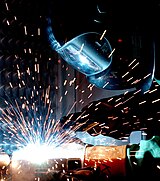Wikipedia:Today's second feature/August 2005
Today's second feature archive
2005
January - February - March - April - May - June - July - August - September - October - November - December
(Today is Friday, November 22, 2024; it is now 08:41 UTC)
- August 6
Today's featured picture
[edit]The typical anatomy of an insect consists of a segmented body supported by an exoskeleton, and a hard outer covering made mostly of chitin.
The body is divided into three sections: head, thorax, and abdomen. The head supports a pair of sensory antennae, compound eyes, and a mouth. The thorax has six legs (one pair per segment) and wings (if present). The abdomen has excretory and reproductive structures.
Full labels on image description page
Illustration credit: PioM
- August 7
Today's featured picture
[edit]
A wildfire, also known as a forest fire, is an uncontrolled fire in wildland, often caused by lightning, human carelessness or arson.
Today, it is accepted that wildfires are a natural part of the ecosystem of wildlands, where, at the least, plants have evolved to survive fires, or even encourage them as a way to eliminate competition from less fire-tolerant species.
Photo credit: John McColgan, US Forest Service
- August 13
Today's featured picture
[edit]
Succulents are plants that store water in their enlarged fleshy leaves, stems, or roots, as shown in this split aloe leaf. This allows them to survive in arid environments.
The enlargement is usually due to the greater amount of the parenchyma tissue. Many succulents have a waxy coating on their stems and leaves, helping them to retain moisture. Having a large internal volume for storage but minimum surface area is also important to prevent drying up.
Photo credit: Raul654
- August 14
Today's featured picture
[edit]
German Chamomile (Matricaria recutita) is an annual plant of the sunflower family Asteraceae. The flowers are borne in paniculate capitula. The white ray florets are furnished with a ligule, while the disc florets are yellow. The hollow receptacle is swollen and lacks scales. The flowers bloom in June and July and have a strong, aromatic smell.
Photo credit: Fir0002
- August 20
Today's featured picture
[edit]
The Teller-Ulam design is a nuclear weapon design used for megaton-range thermonuclear weapons or hydrogen bombs. It uses a fission bomb as a trigger to ignite a fusion explosion by compressing the fusion fuel with a radiation implosion. It is named after two of its chief contributors, Hungarian physicist Edward Teller and Polish mathematician Stanisław Ulam, who developed the design in 1951.
Illustration credit: Fastfission
- August 21
Today's featured picture
[edit]
The heliosphere is a bubble in space produced by the solar wind, the stream of charged particles emanating from the Sun. At some distance not exactly known, far beyond the orbit of Pluto, this supersonic wind slows down to meet the gases in the interstellar medium, producing several shock boundaries. This diagram shows the position of Voyager 1 as it crossed the termination shock and entered the heliosheath at a distance of 94 AU some time around December 2004.
Illustration credit: NASA
- August 27
Today's featured picture
[edit]
Gas metal arc welding is a semi-automatic or automatic arc welding process that utilizes a welding gun through which a continuous and consumable wire electrode and a shielding gas is fed. A constant voltage, direct current power source is most commonly used with GMAW, but constant current systems, as well as alternating current, can be used. It was originally developed for welding aluminum in the 1940s, but its high welding speed has led to its use in welding steel, especially in industries such as the automobile industry.
Photo credit: William M. Plate Jr., USAF
- August 28
Today's featured picture
[edit]
A mouse is a handheld pointing device for computers, involving a small object shaped to sit naturally under the hand, that can detect its motion relative to a flat surface and usually fitted with one or more buttons. The 2D motion of the mouse is typically translated into the motion of a cursor on the display. The mouse was invented by Douglas Engelbart of Stanford Research Institute in 1963 after extensive usability testing. It was one of several experimental pointing devices developed for Engelbart's oN-Line System.
Illustration credit: Jeremykemp
Today's second feature archive
2005
January - February - March - April - May - June - July - August - September - October - November - December
(Today is Friday, November 22, 2024; it is now 08:41 UTC)

